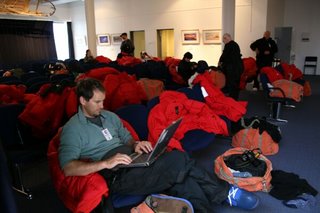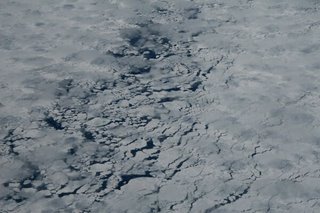White again
We're back in Antarctica! This will be my 5th season and Grant's 11th. Our group this year consists of 10 people. Seven of us (David Ainley, Kate Dugger, Grant, myself, Ian Gaffney, Amelie Lescroel, and Valere Marsaudon) just arrived together, while three more (Jean Pennycook, Lloyd Fales and William Sladen) are coming in December and January. In addition to the usual penguin research, this year we're also filming an educational DVD about the project, which Lloyd Fales is directing and producing. Ian and Grant will be filming a lot of the footage over the next couple of months.
We arrived at McMurdo station on November 7th and are scheduled to fly to our field camps on November 15th, weather permitting. We're going through the usual debriefing, sorting, packing and making sure that we have enough supplies for the next two and half months in the field. It's an exciting and stressful time - amazing to be back in this breathtaking place, overwhelmed with all the work that lays ahead, and excited at the prospect of spending the next 10 weeks at Cape Crozier.

USAP terminal
Grant waiting at the US Antarctic Program's terminal in Christchurch, New Zealand. The red parkas strewn across the chairs are part of the ECW (Extreme Cold Weather) clothing provided by the program.

Inside the C-17
The c-17 is a military cargo plane that flies people and cargo to and from Antarctica. Our flight was loaded with telescope parts (big white structures) bound for the South Pole. The flight from Christchurch to McMurdo lasts about 5 hours, with an additional 3 hours for those going to the South Pole.

Sea ice
The C-17 has very few windows - two near the front and two near the back - so for most of the flight I was unable to see what lay below. As we neared Antarctica I became quite restless and frequently wandered up front to check for the first signs of a frozen landscape. This is a glimpse of pack ice through the low clouds. We flew over hundreds of miles of ice-covered ocean before seeing any terra firma.

Antarctic mountains
I invited myself into the cockpit to take in the stunning landscape - sea ice giving way to rugged, rocky coastline to glaciers flowing into the sea to endless mountains blanketed in snow and ice...

Sea ice runway
Approaching McMurdo, which is a research station of about 1200 people tucked into the small bay beneath the last hill (Observation Hill) in the center/background. The flat white in the foreground is all frozen sea, with the sea ice runway in the foreground. The C-17 lands on about 1.5 meters of ice, thick enough to absorb the impact of a landing cargo plane without cracking and sending us into the frozen depths of McMurdo Sound. By December the sea ice runway turns into slush or open water, so the airport has to be moved further south onto the Ross Ice Shelf, which lays between Observation Hill and White Island (left background) and stretches hundreds of miles to the south. The ice shelf is about a hundred meters thick and is strewn with crevasses and giant "rollers" of flowing ice in some areas.

Getting off the plane

0 Comments:
Post a Comment
<< Home